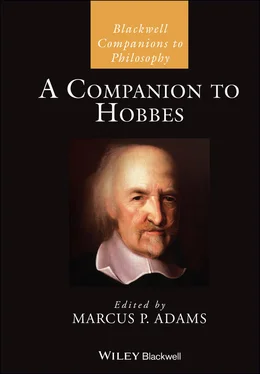(Hobbes 2012, 50; 1651, 12–13)
And, finally, Hobbes writes in De corpore : “A NAME is a word [ vox ] taken at pleasure to serve for a mark, which may raise in our mind a thought we had before, and which, being pronounced to others, may be to them a sign of what the speaker had, or had not, before is mind ” (EW I.16).
These definitions characterize names by their function. As Biletzki (1997) and Hungerland and Vick (1981) emphasize, Hobbes’s nominalism and materialism effectively preclude him from adopting any view about the metaphysics of meaning according to which there are entities answering to the “meanings” of sentences. Hence, although names in speech signify thoughts, thoughts must be taken as psychological episodes and not abstract objects (i.e., Russellian propositions or Fregean Sinne ), since Hobbes denies such things exist. Furthermore, the signification of a name is not anything denoted by the name. Hobbes very clearly distinguishes that which a name signifies from that which a name denotes, or is “imposed” on (about which I shall say more below). 4
These definitions confirm that the pragmatic “use” theory of meaning reading is the correct one. The essence of a name consists in the use to which that name is put. It is a mark, for the sake of recalling thoughts of the objects on which it is imposed; it is an interpersonal communicative sign, when “pronounced to others,” in the context of a sentence, to express thoughts. Although Hobbes has a lot to say about communicative speech acts and the non-cognitive, expressive uses of language (e.g., Hobbes 2012, 94; 1651, 29), and although these feature prominently in his political and ethical theory (Biletzki 1997; Holden 2016; Pettit 2008), it is clear from the foregoing definitions that the cognitive use – registering the consequences of thoughts in declarative sentences – is the primary one.
Both Leviathan and De corpore are straightforward regarding the relative priority of the two uses of names in speech. In Leviathan , the cognitive use is called, explicitly, the first use of names. In both Leviathan and De corpore , Hobbes gives brief arguments justifying the definition of names and both of these imply that the communicative function of names in overt speech as signs of thought derives from the use of names as notes for the sake of remembrance. In Leviathan , Hobbes argues that it is because the general use of speech is to “register thoughts” that the “first use of names” is to serve as notes of remembrance. What speech generally is useful for is registering thoughts; so, then, an individual name primarily is a token for thought. In De corpore , Hobbes argues that, since an individual person – working alone – can construct names for the things he observes and register his thoughts about them, a name is a mark for thought. But, given that he is a social being and dependent upon others for the preservation and enlargement of his knowledge, he must teach his marks to other people, making them into signs of his thought (EW I.14–15). Hence, although names are both marks for private cognition and also signs for communication, “they serve for marks before they be used as signs” (EW I.15) and cannot be signs “otherwise than by being disposed and ordered in speech” (EW I.15). “ So that ,” Hobbes says, “the nature of a name consists principally in this, that it is a mark taken for memory’s sake; but it serves also by accident to signify and make known to others what we remember to ourselves ” (EW I.15; emphasis added). Therefore, he concludes, names are accurately defined in the manner expressed at De corpore 2.4 (EW I.16) – marks as instruments for thinking and, also, when expressed to others, signs for the communication of thought (EW I.15).
5.3 Truth and Propositional Judgments
Without the use of language an animal’s ability to make inferences, to navigate, know about, and manipulate the world, is exhausted by its power to make successful conjectures by signs. Though good enough for an animal’s daily needs, natural prudence is limited in two important respects, both of which Hobbes characterizes as problems with the memory (e.g., EW I.13–14; EW IV.20). First, as I have already pointed out, since conceptions are not general concepts, the mind cannot naturally form general representations – concept possession, without language, consists in an organism’s ability to project regularities, remembered and recalled as signs. In Leviathan (Hobbes 2012, 52; 1651, 13) and De corpore (EW I.80), Hobbes gives the example of a person doing geometry without using language to make the point. By observing figures in sensory experience – by drawing a diagram and visually inspecting it, perhaps – a person can come to recognize that the sum of the interior angles of a triangle equal two right angles. However, without a general representation of triangularity , “if another triangle be shewn him different in shape from the former, he cannot know without a new labour, whether the three angles of that also be equall to the same” (Hobbes 2012, 52; 1651, 4). Using only his natural cognitive powers his possession of the concept of triangle is limited to his ability to reliably conjecture, from his memories of particular triangles, that the next triangle he encounters will also have interior angles equivalent to two right angles; without the capacity to deploy general representations in cognition, he cannot permanently store the inferential sequence that led him to discover that the interior angles of a three-sided figure are equal to two right angles.
The second problem is that the decay of conceptions introduces errors into the natural process of inference. Since natural cognitive processes involve a “comparison” of ideas, as ideas lose their informational capacity, so they become less and less reliable when deployed in inferences. “Tacit errors, or errors of sense and cogitation” arise, therefore, in the transition from one mental representation to another in inferential processes (EW I.56–7). Hence, for example, without a “sensible measure” by which to preserve the fact that a given figure was so many units wide, it will not be possible for a person to reliably infer that some new figure she encounters has a width of the same number of units (EW I.13).
To overcome these limitations, human beings invent marks: “sensible things taken at pleasure, that, by the sense of them, such thoughts may be recalled to our mind as are like those thought for which we took them” (EW I.14; also EW IV.20). Marks are genuine symbols , in the sense that they are physical tokens, the meaning of which is fixed by conventions governing their use. The point of marks is not so much to help forgetful people remember things they would not otherwise have remembered (although marks can do this); rather, more generally marks help the mark-user raise conceptions in her mind to make inferences and to guide her behavior. The symbolic import of a mark is constituted by its function in cognition. The example Hobbes gives in Elements of Law of sailors who float a buoy to mark a submerged rock to “remember their former danger, and avoid it” (EW IV.20) illustrates the point. The sailors in Hobbes’s example recall that there is a potentially dangerous rock below the water’s surface; they just cannot see the rock from their boat, as they approach it. The buoy, as a mark, causes the sailor to think about the rock (i.e., to raise conceptions of the rock) and they can take appropriate action; that is the sense in which the buoy helps the sailors’ memory. The sailors introduce the device to help themselves recall the rock so that they can then make deliberations, take action, etc. The buoy thereby “points to” the submerged rock, because it causes a sequence of conceptions involving conceptions (memories) of the rock. What makes the buoy a mark is the functional role played by the buoy in cognition. By a standing convention – a rule governing its use – the causal role of the buoy is fixed and, as a mark, it is able to reliably convey information from one time to the next. To grasp the symbolic import of the buoy as a mark is to know the role of the buoy in cognition.
Читать дальше












